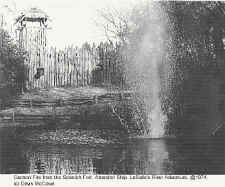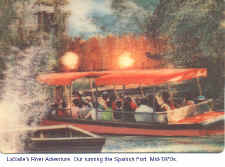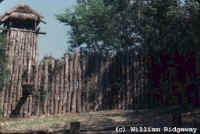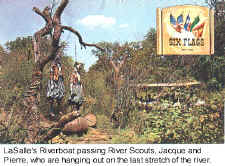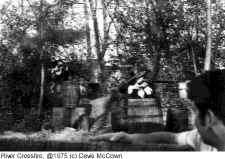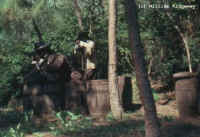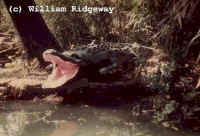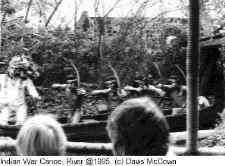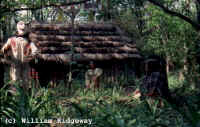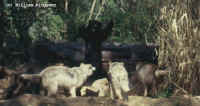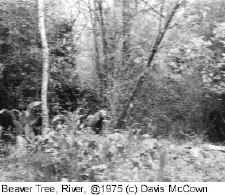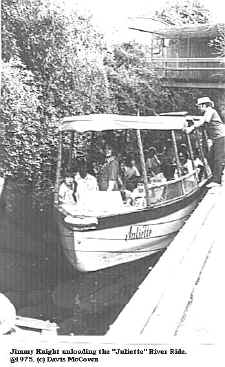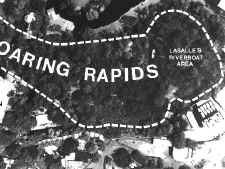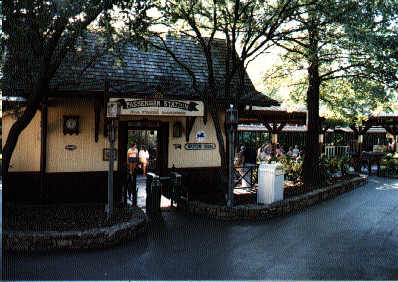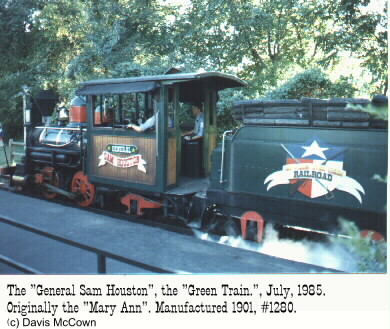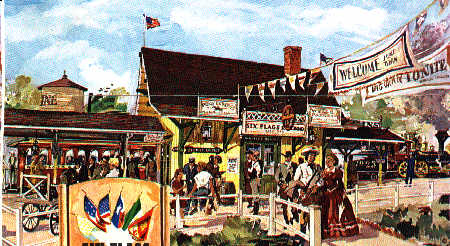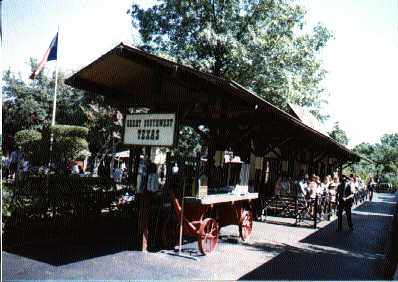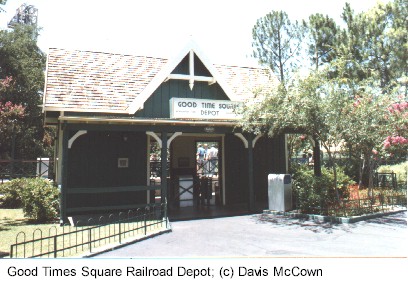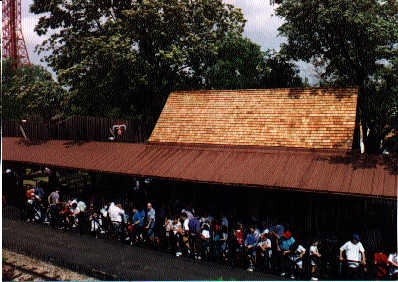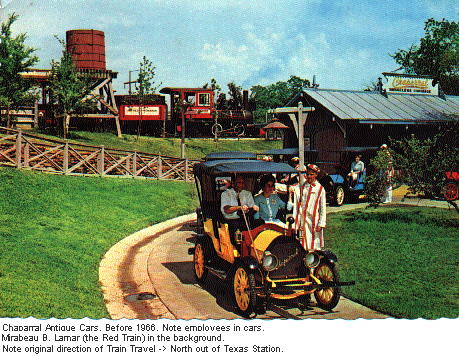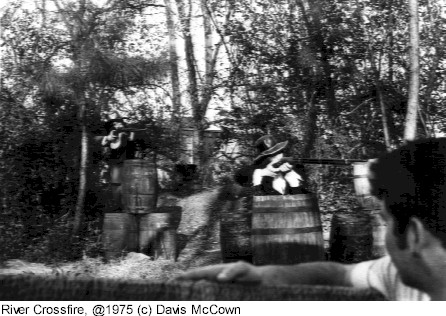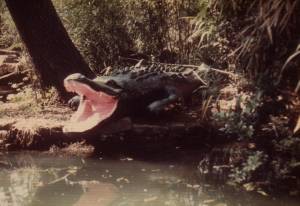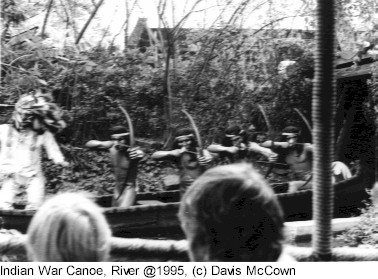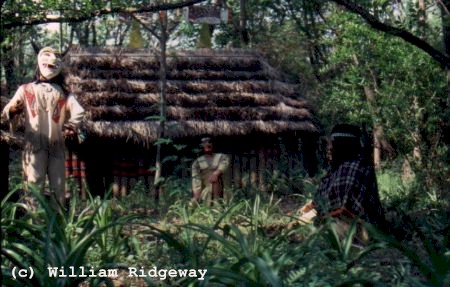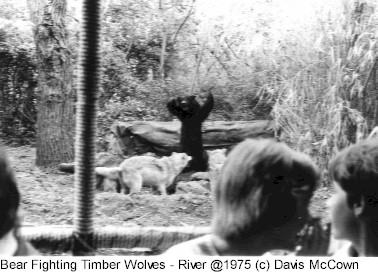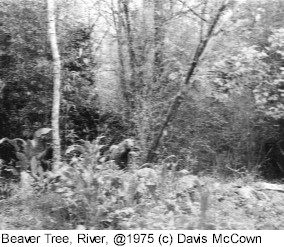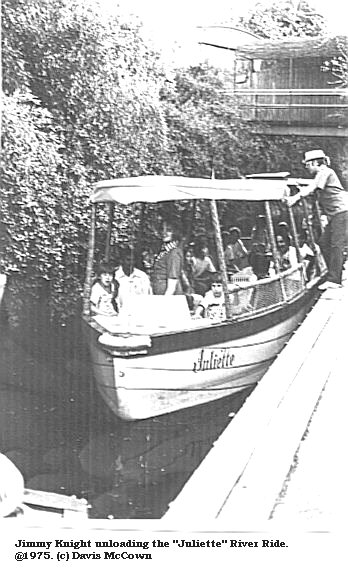Category: Original Attractions
Los Conquistadors Coronado Burro Ride
Last Year Operated: 1962
Section: Spain
Manufacturer:
Other Names and Nicknames: Burro Ride
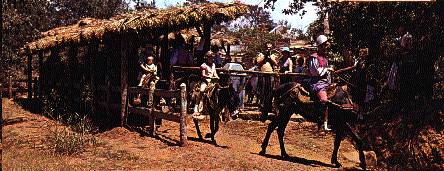
The Burro ride was a live animal ride which operated for the park’s first two seasons at what is now the site of the Log Flume Ride. For its short existence, the ride was basically the only attraction for the park’s Spanish section.
The premises of the ride was that the guest were following in the shadow of Spanish conquistador Francisco Vasquez de Coronado. The journey consisted of a mule-back descent into Palo Duro Canyon in a search for the seven cities of Cibola. The trip was guided by a host dressed as a Spanish conquistador.
Along the way, the guest viewed the restored ruins of the first Spanish Mission to Texas, the Mission San Francisco de los Tejas.
The attraction was removed at the end of the 1962 season to make way for the Log Flume ride.
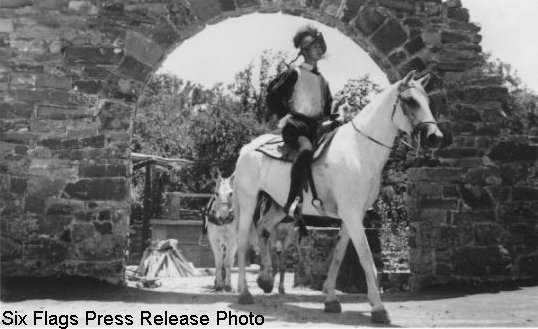
Crazy Horse Saloon
Last Year Operated: Currently Operating
Section: Texas
Manufacturer:
Other Names and Nicknames:
Crazy Horse Saloon Theater
The Crazy Horse is show saloon, complete with a small stage for western singing and can-can dancing, as well as a bar. In keeping with the park’s family friendly atmosphere, park promotional materials make it very clear that “although it is a saloon, only soft-drinks are sold there.”

The theater is rather small, with room for a small stage, a piano, and several tables for the guests. Four or five performers in saloon costumes sang period songs, danced on the stage and mingled with the guests.
In keeping with the park’s historical emphasis, the entire back bar is an actual antique bar from an 1890 vintage saloon. Carpenters crafted a new front bar to conform to the original. Antique tables and chairs were acquired from a saloon in Little Rock, Arkansas.
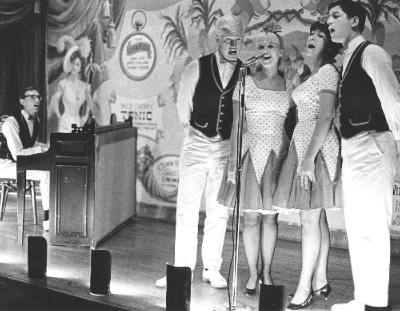
While there are shows and performers in all of the sections of the park, the Crazy Horse is unique in that is the park’s first indoor show. It continued as the park’s only indoor show for the first seven years of operation, until the much larger Southern Palace replaced the amphitheater in 1968. It is also the longest running theater in the park, operating continuously since the first season. Inside, the singing and dancing showgirls still entertain visitors.

Being the only indoor theater, the Crazy Horse also served as an employee auditorium, being used for orientation sessions, training, and other meetings
The Crazy Horse Saloon opened with the Park in 1961 and is the oldest theater in the park.
The Gunfighters
Last Year Operated: On-going
Section: Texas
Manufacturer:
Other Names and Nicknames:
Section: Texas
Year installed: 1961
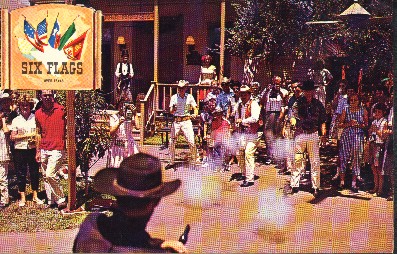
The Gunfighter Shows have been held in the Texas section since the park opened in 1961. The shows recreate the good-guy/bad-guy shoot-outs of the wild west. They are designed to be entertaining more than historically accurate. Typically they take place on the street in front of the Courthouse in the Texas Section. Over the years, however, shows have been held in various locations around the park. In some shows, outlaws rob the Train while it is running, leading to a shoot-out in front of the Texas train station. Shoot-outs have also been held in front of the Jersey Lilly, around the corner from the Courthouse.

Starting in 1994, the Texas section hosted the Texas Backlot Stunt Show, an outdoor action-comedy stunt-show featured in the Texas section. Additional sets were built next to the Jersey Lilly for this show. The first show, the O.K Corral Shootout Backlot show,was tied to the release of the Warner Brother’s movie Wyatt Earp. The stunt shows continued through the 1990s.
At this time, the Gunfights continue in front of the Courthouse.
Railroad
Last Year Operated: Currently Operating
Section: Texas
Manufacturer:
Other Names and Nicknames:
The Six Flags Over Texas Railroad
See also the complete SFOT RailRoad Spiel – 1974
See also the complete SFOT RailRoad Spiel – 1961
The Six Flags Railroad is the oldest operating attraction at Six Flags Over Texas and has the distinction of being the ONLY attraction remaining from the park’s initial season.
The trains make a one mile run around the park. The ride is enhanced by the “Spiel of the Conductor“, which points out the sights for the riders, highlights interesting facts about the park, and provides some “corny” entertainment. The spiel changes over the years as new attractions are added and others are removed.

The Engines
The center pieces of the Railroad are the two engines, each of which has an extensive history of its own. Engine Number 1 is known as the Green Train due to its green paint scheme. The Green Train was constructed in 1901 as Engine 1280 of the Dickson Works of the American Locomotive company.
Engine Number 2 is known as the Red Train for its red color scheme. It is the older and smaller of the two engines. It was manufactured in 1897 as Engine Number 1754 of the Porter Company.
Enterprise Plantation
Both Engines were originally built for the Enterprise Plantation, a Sugar Cane Plantation, in Patoutville, Iberia Parish, Louisiana, owned by the Patout family. The Red Train was Enterprise’s first engine and tender and was named the “Lydia”. The Green Train was Enterprise’s second engine and tender and was named the “Mary Ann”.
The Engines were part of a fleet of 8 engines and 220 4 ton cars eventually owned by the plantation railroad, which operated until 1945.
The Engines are Narrow Gauge (36″), meaning that the distance between the two tracks is thirty-six inches. This is smaller than Standard Gauge Railroads, but allows for better maneuverability on tight tracks.
Both engines were leased to Six Flags Over Texas by the Patout Family when the park opened in 1961. As of 1995, the Trains still operated in the park under a lease agreement.

Six Flags Rebuilds the Engines
The Green Train, originally the “Mary Ann” at the Enterprise Plantation, was renamed the “General Sam Houston” by Six Flags, in honor of the Texas hero. Its pulls four cars, and is the primary train of the railroad, operating even on slow days when only one of the two trains is running.
The Red Train, originally the “Lydia” at the Enterprise Plantation, was renamed the “Maribeu B. Lamar”, also in honor of the a Texas hero. It pulls a compliment of three passenger cars. It usually runs as an extra train on crowded days.
The two engines were rebuilt by the park at an estimated cost of $50,000 each. Photographs of the original “Lydia” and the “Mary Ann” hang in the lobby of the Texas Station. Due to reconstruction of the engines, they look different from their current appearance and may not instantly be recognized. A lantern and cattle guard was added the front end of the each train. The Engines are no longer wood burning and the tenders were converted accordingly. Additional guide wheels were added to the front of each engine under the cattle guards.
The front smoke stack on the Green Train was modified. On the Red Train, the covering for the Engineer and Fireman was moved back on the engine and additional windows were added.
The passenger cars were also built for the park.
The Red Train has since been renamed to the Charles Jefferson Patton, in honor of the engineer that operated the Six Flag engines for many years. The Green Train has been renamed in honor of Larry Cochran.

The Engine House
The home to the Trains is an engine house built in the Southwest Corner of the park, outside of the Spanish and Mexican Sections. The Engine House can be viewed by Guests as they ride the trains.
Train Operations – Sights
The Trains originally operated only out of the Six Flags Railroad Station in the Texas Section. The station was officially named the “Great Southwest Station.” Trains left the Texas Station heading North towards the Chaparral cars. They made a non-stop round trip run around the park, which was completely enclosed by the track. Along the way, riders could see some of the parks rides and attractions. Some of the route, however, was through as of yet undeveloped areas of the park. The park added sights to these areas. In what was to become the boomtown area of the park, Buffalo lived in pens for viewing by guests on the trains.
The trains made their one way run until Six Flags added Boomtown in 1963. The Boomtown Station was added as part of the boomtown section and the trains began the tradition of stopping on the east end of the Park so riders could disembark and new riders could embark.
When the StageCoach ride closed, the “Ghost-town saloon” animation was moved to become part of the train’s landscape. Likewise, in 1968 when the Fiesta Train was rebuilt, the Train landscape became the home of several of the old Fiesta Train’s animations, including the “dancing tamales“. This section of the landscape became known as “Mexican Junction”, although the Trains never actually stopped there.
Station Houses
The ride stayed basically the same until Six Flags added Good Times Square in 1973. At that time, the old Boomtown Station house was removed and the Good Times Square Station was added in its place. Rather than being inside the track like the Texas and Boomtown Stations, the Good Times Square Station was on the outside of the track. The Passenger cars were modified accordingly so that they could be entered from either side.
At the same time that the Good Times Square Station was added, the Trains were “turned” so that they ran the opposite direction, leaving the Texas Station South, heading towards the flume. Of course, the Conductors now how to learn to spiel “backwards”.
The Trains were “turned” again in the early 1980s, so that they now depart Texas in the same direction as they did in 1961, heading North, towards the Chaparral cars.
In 1987, the Good Times Square Station was removed to make way for the Mr. Freeze Ride. At that time, a new Boomtown Station was built.
Texas Station has now been renamed from “Great Southwest Station” to the “Johnson Creek Station“.
The Six Flags Railroad is an official operating railroad regulated by the Texas Railroad Commission.
An Official Texas Historical Plaque hangs on the outside of Texas Station, documenting the history of Narrow Gauge Railroads in Texas. The plaque, placed in 1966, incorrectly states that the engines were originally manufactured in 1887 and 1903.
The Trains remain a popular ride, in that they can be enjoyed by both the young and the old. More importantly, the preserve a piece of American history that many generations can only read about. Hopefully, the whistle of the engines will always be heard throughout the park.
(c) 1998 Davis McCown

Skull Rafts
Last Year Operated: 1976
Section: Confederacy
Manufacturer:
Other Names and Nicknames:
The Skull Island Barges were rafts that took Guests to and from Skull Island.
Skull Island
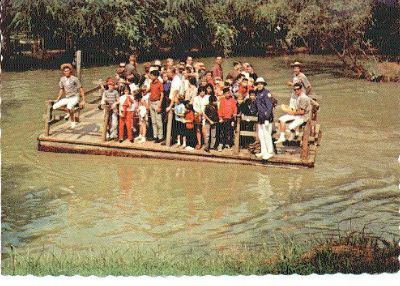
LaSalle’s River Adventure Spiel
Six Flags Over Texas
Mid 1970s
Good day my friends, I would like to welcome you aboard our little French Riverboat the [Nadine, Elizabeth (Belle), Juliet, Annabelle, Henrietta, Suzanne, Marguerite, Maria, Isabelle, Paulette, Georgette]
I am your captain and as we pull away from the dock, I would like to remind you to keep your arms and legs inside the boat at all times, for if you leave them out for just a ‘little too long’, ….they may come back a ‘little too short’.
Leaving the Dock
Boat pulls away from dock and starts around a corner
For we will be traveling down the dangerous Lavaca river which in 1861, our leader, Cavalier De LaSalle sailed looking for an alternate route to the Mississippi River. But he has was never been heard from since.
So that we don’t meet up with his same fate, I have sent ahead a French Riverboat captain and two river scouts, Jacques and Pierre, there camp should be just around this bend,
but wait? /excited voice/…. oh no? it looks as though the Indians have attacked the camp.
Campsite
a campsite; fires burning from the battle;
dead Indian figures laying on the ground;
dead riverboat pilot lying on a sea chest with an arrow in his back
There is our river boat captain, lying on his chest. That’s him in the arrow shirt. It looks as though he got the point of the Indian message.
But I don’t see our river scouts, Jacques or Pierre, anywhere about, perhaps they escaped with their lives and we can find them as we continue our journey down the river. I certainly hope so, because we will be lost without them.
Over to my left is a pack of hungry timber wolfs and it looks like they had someone over for dinner. I don’t think that they will be bothering us.
Timber wolfs
Pack of wolfs sitting around a pile of bones.
Over to my right is a more friendly scene. Some friendly Tejas Indians are helping the Friar build the Mission San Francisco de los Tejas.Spanish Mission
Partial log mission, Indians carrying logs
Friar looking at scroll and nodding up and down.
You know, though, they have been building that Mission for 17 years and they still aren’t through. Maybe they should just rename it….’Mission Impossible.’
But wait, /quietly/ up ahead is a Spanish Fort. And as you all know, Spain and France have been at war for ten long years over this little piece of land known as Texas. Perhaps if we are very quiet, we can sneak by. But wait, they have spotted us.
Spanish Fort
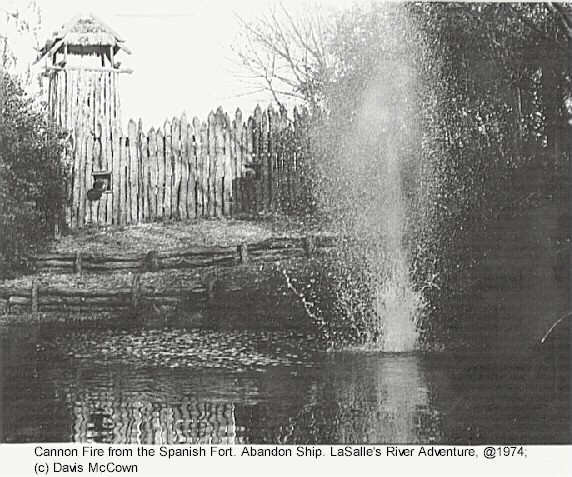
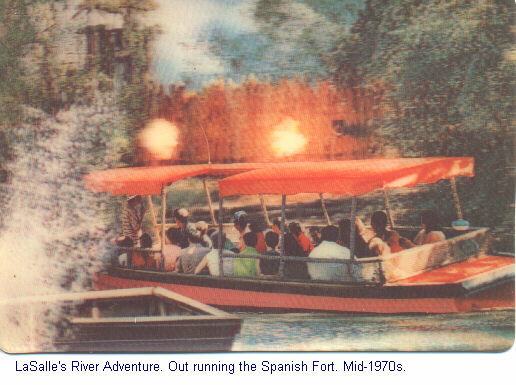
Spanish Officer raises up in the fort watch tower
and drops his sword signaling the cannons to fire.
Each of three cannons begin to fire, three times each.]// As the cannons fire
Oh no. I near miss to the front and another to the side. We will have to abandoned ship, Women and Children first, AFTER THE CAPTAIN OF COURSE. But wait, they have stopped. It appears as though the Spanish can’t even hit the broad side of a little French River boat and we can continue on our journey in safety.
But don’t look to my right. There’s Jacques and Pierre, our two French River Scouts, hanging from that tree.
Jacques and Pierre
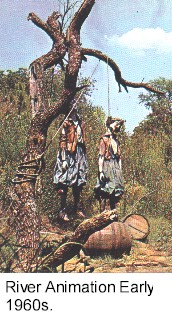
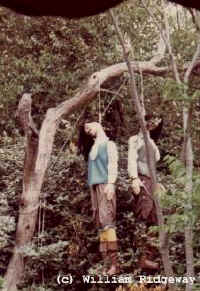
Two French river scout type figures
are hanging by their necks from a tree branch.
Oh well:It looks like they are at the ‘ends of their ropes’.Oh Jacque and Pierre, they always were the ‘swingers of the swamps’.There they are, just ‘hanging around’.It seems that they found the last ‘stretch of the river.’
I guess we will just have to travel on without them, but wait, look up in that tree, it is the Famous French Fur Trapper, Francis. I’ll just ask him if it is safe to go on.Fur Trapper
French fur trapper sitting high in a tree, shaking his head. // Yell out of the boat. Francis, is it safe to go on?
Look, as you can clearly see, he is shaking his head back and forth, which in French means ? ‘no.’ We could turn around, but I don’t think we would get past that Spanish Fort again, so we will have to continue onward.
You can also see Francis shaking his leg back and forth. After 17 years in that tree, I think that is French for… ‘I need to go to the restroom.’
But wait, did you hear something ahead?//popping sound
Cross Fire
Indians on inside of river shooting at Frenchman hiding behind wine barrels on the outside of the river. Wine is leaking out of barrels shot in the fire fight.
Oh no, we are caught in a cross fire between these Indians on this side and our own Frenchman on the other. Everyone down to the bottom of the boat, for it would be quite a shame to be shot by one of our own country men.
I think that we made it safely by.
But look what the Indians have done to those barrels of wine. Once King Louie finds out what is happening to the wine that he is shipping to Texas, he will start sending Milk instead.
We have now entered the most dangerous part of the river, the ‘uncharted territories’. As you can see, everywhere are dangerous alligators, just waiting to make a meal of us. Why I have been told that there was once an English Teacher that stuck her hand outside of the boat right here, // pointing to alligators open mouth….
and now, she is teaching ‘shorthand.’
Oh no, everyone down, that’s a Caddo war party and those arrows are poisoned tipped, one scratch would mean instance death. That was very close, luckily they have decided not to fire.War Canoe
war canoe appears and moves behind the bushesPop-Up Bear
beside the boar on the other side, a bear pops up and growls
Don’t worry, that just a bear fishing for his dinner in the river.
Over here is a Caddo Indian burial pier, the Indians buried their dead six feet above the ground in the hopes that that would give them a head start to the happy hunting grounds above.
Here a momma bear and her cubs are stealing some honey from those bees. And boy are those bees mad. Then again, I bet you would be pretty mad if you came home one night and found out that some animals was ? trying to steal ‘your honey.’
Over here is an Indian village and the Medicine man is trying to ward off the evil sprits.Indian Village
Hay ya, Hay ya, Hay ya
Indian Medicine man dancing around pot on the fire
Indian women cleaning clothes in the river
But wait, //excited// if you look carefully, you will see that all of the warriors are gone from the village. And when all of the Indian warriors are gone from an Indian village, it can only mean one thing,
…..’they are somewhere else.’ Lets hope that we don’t find out where.
Wait, everyone quite, there’s a cougar looking for his dinner, one wrong move and we will be it.
Quite everyone, ? careful,
Careful,
The Cougarcougar is on a branch hanging out over
the river next to the boat, slowly the
boat passes the cougar by.// Very loud scream:
on no, look out.
// calmer // – I thought he had that little fat man at the back of the boat.
Bear fighting Timber wolfsLarge bear waving off five timber wolfs.
Here to my right a bear is fight off a pack of hungry timber wolfs. And as you can clearly see, he is fighting them… ‘bear handed’. I bet that he will… ‘barely’ escape from that situation. I just can’t …’bear’ to watch.
Look though, there are only five wolfs in that pack. If there had been one more, that poor bear would have been up against ‘a six-pack’.
Oh no, everyone to the side of the boat, as you can see on my right, there’s a river whirlpool dragging that poor soul to a watery grave.
The Whirlpool
hand sticking up from the water
holding a stick going
around (causing?) in a whirlpool
There is one thing that I can say about him however, he sure knows his way ‘around’ this swamp?
….and around? and around?
Over here is a more friendly scene, a group of beavers are hard at work building a dam. But wait a minute, look out,
Beavers
Beavers standing in clearing near small tree//excited// that tree is going to fall,
T I M — B E R.
Why, I do believe if that tree had been just a little bit longer, this boat would have been ….just a little ‘bit shorter’.
‘Leave it to Beaver’ to pull a stunt like that.
It seems that one have come to a fork in the river and I don’t know which way to go. I guess we should try this way.
But look out, everyone down. We are surrounded by Caddo Warriors. I guess we should have gone the other way.War Party
Indians on both sides of the River
threaten the boat with spears and arrows.
Everyone smile and perhaps they will think we are friendly. It looked like it worked, they are letting us pass,
but, oh no, here is why. We are heading for a waterfall and a solid rock wall behind it. The river is much to narrow to turn around here and we can’t go back past those warriors. I guess this is the end of our journeyThe Waterfall
ahead is a Water fall and behind it is a solid rock wall. // The captain stops the boat.
But wait, the wall is opening.// Boat starts back up.
We must have discovered a secret Indian treasure cave, for the Indians were known to hide their treasure in caves such as this.
The Cave
treasure chest with dead skeletons. (as opposed to live skeletons?)
looks more like a pirate cave than an Indian cave.
Look out,
// skeleton swings out from the dark.
It looks like that pour sucker has been on ‘a crash diet’.
There is the treasure, it looks like many that have tried to take it have paid with their lives.
Oh no, the walls behind us are closing, we are trapped inside.// boat moving very slowly.
But wait, the walls in front are opening, the Indians are repaying us with our lives for not disturbing their treasure.
And look, there is the flag of France, viva La France, we have made it back to Fort St. Louis and safety.
Back to Dock
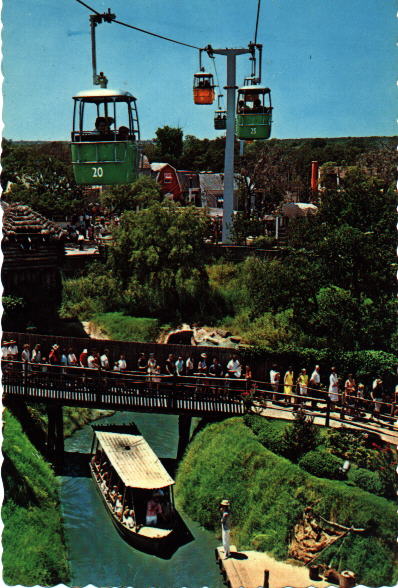
Back where we started
As the boat approaches the dock, I would like to remind you to keep your arms and legs inside the boat and please remain seated until the boat comes to a complete stop.
I hope you enjoy your day here at fun filled Six Flags Over Texas.
Crew claps and cheers and goes wild.
End of Spiel
Unloading Spiel: // in sort of a rambling manner.
Please watch you head as your heading out, and watch your step as your stepping out, but most importantly of all, watch out for my poor aching feet.
You see I have been standing on them all day long, and so have about a hundred other people. The difference is, I like to stand on the bottoms, and they like to stand on the tops.
Why just this morning a spaceship full of half-crazed Martians landed at the front gate, got out of their ship, checked their brains in at the public lockers and came down here just to step on my feet.
Enjoy your stay here at Six Flags Over Texas and remember that there is only [insert exact count] shopping days left until Christmas.
A few notes about this Spiel:
- This is not a verbatium copy of an “official spiel”. which was handed out to employees. That was more of a guideline to help each employee get started.
- This is very similar to what was actually said during the 1974-77 seasons.
- Each “River rat” spieled differently from the official spiel, other employees. Even an individual’s own spiel could vary between trips. Each captain had alternate remarks for the various animations and added comments if the boat was running slow.
- The spiel also changed over time, especially since the animations were occasionally changed.
- Around 1975, one boat was renamed the “Belle” in honor of Alan Bell, a supervisor at the time, which was interesting, as one of La Salle’s boats was actually named the Belle.
Goat Carts
Last Year Operated: 1963
Section: Mexico
Manufacturer:
Other Names and Nicknames:
The Goat Carts were authentic goat carts, small wooden carts in which two or three small children sat in the cart as it is pulled around a dirt path by a goat. The path was boarded by a small wooden fence to keep the goats from wondering off. An attendant walked along with the cart and keeps the goat moving. The Goat Carts were short lived and were removed from the park at the end of the 1963 season, after three years in the park.
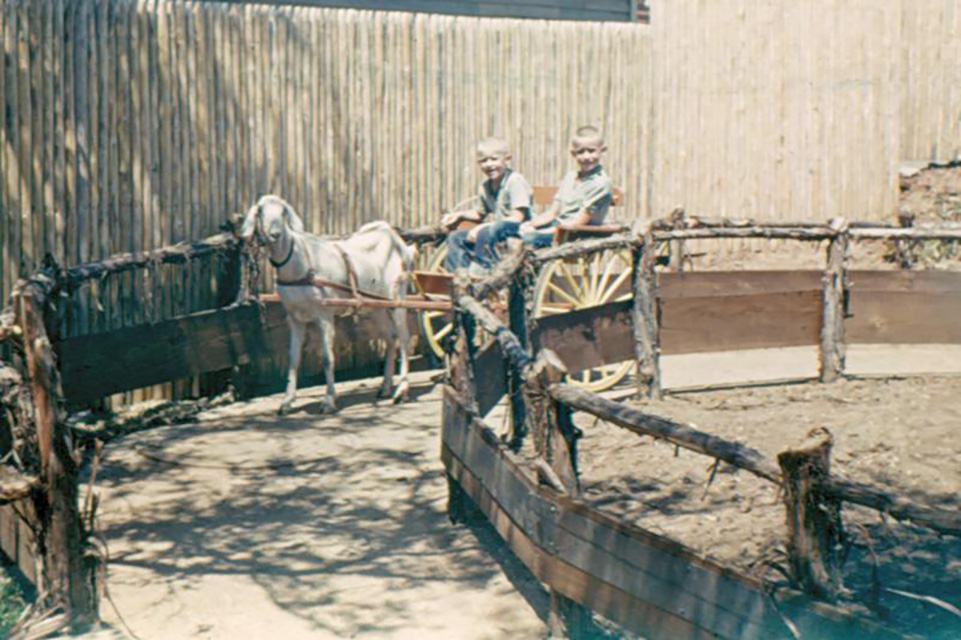
Sidewinder Rollercoaster
Submitted on Sun, 08/15/2010 – 10:55
Last Year Operated: 1964
Section: Mexico
Manufacturer: Herschell Company
Other Names and Nicknames: La Cucaracha
One Rollercoaster – Two Names
The Sidewinder has the distinction of being the first roller coaster at Six Flags. It was also the only roller coaster in the park for the first four years of operations.
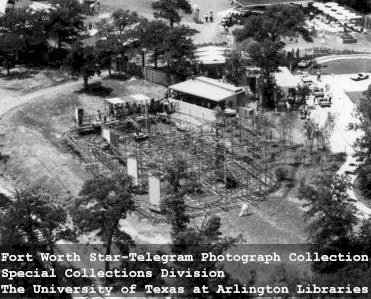
The ride, a “Cat and Mouse”, style metal roller coaster consisted of individual units, each of which could hold one or two riders. As with most coasters, the cars were pulled up a lift hill. Instead of traveling down a straight fast and steep drop, however, they descended down a winding track with sharp turns. The wheels were set back to the rear of the unit, so that as the car approaches a curve, the front end sticks out over the edge of the track before the car started turning. This design creates the illusion that the cars are constantly about to run off of the track.
The ride only operated as the “Sidewinder” for first season. For the 1962 season, it became the first ride in the park to be moved to a second location as it was relocated to the Mexican Section a and renamed the “La Cucaracha”.

Future Site of Happy Motoring Track II
The ride was manufactured by Herschell Company under the name of the Mad Mouse.
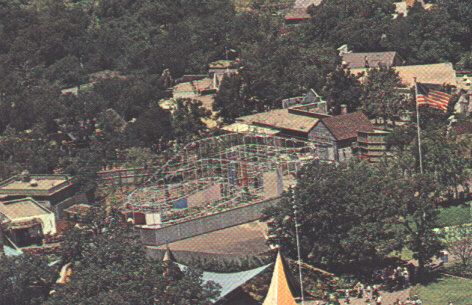
La Cucaracha in the Mexican Section
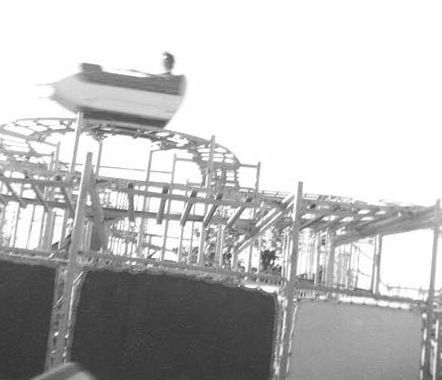
The Indian Village
Last Year Operated: 1967
Section: Mexico
Manufacturer: None
Other Names and Nicknames:
The Indian Village
Although the Native Americans did not have a flag to be recognized in the park’s theme, they did play an important role in the development of Texas. As such, an area representing their contribution was appropriate.
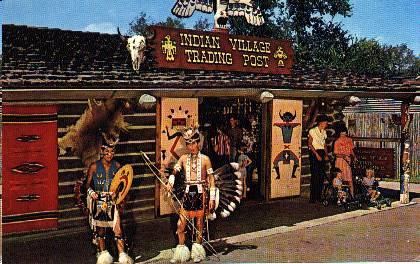
The Indian Trading Post and Village is not contained within a single section, but rather sets on the border between the Mexican and Texas sections. The front of the Indian village is the trading post. The Trading Post is a large souvenir shop selling Western and Indian related items.
Behind the trading post was the Indian village. A set of four tee-pees sat in the corners of a small square blacktop performance area. Here Native Americas performed authentic hoop dances during the day. Typically, two Native American’s perform the Hoop dance with wooden hoops, not unlike a hula hoop. A third slowly marks time on an Indian tom-tom.
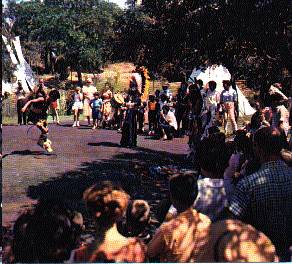
The Indian trading post still sits at is original location. The Indian village, however, has been removed.

